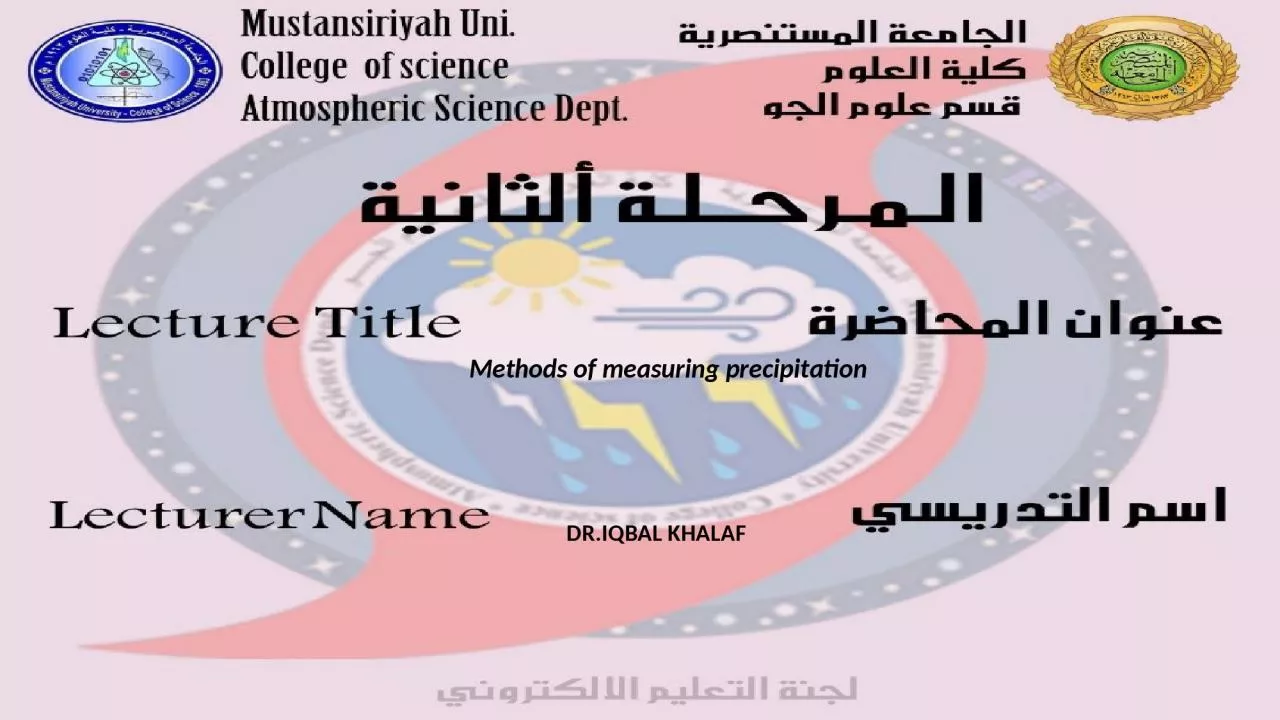

Precipitation can be divided into three categories based on whether it falls as liquid water liquid water that freezes on contact with the surface or ice Mixtures of different types of precipitation including types in different categories can fall simultaneously ID: 1025156
Download Presentation The PPT/PDF document "DR.IQBAL KHALAF Methods of measuring ..." is the property of its rightful owner. Permission is granted to download and print the materials on this web site for personal, non-commercial use only, and to display it on your personal computer provided you do not modify the materials and that you retain all copyright notices contained in the materials. By downloading content from our website, you accept the terms of this agreement.
1. DR.IQBAL KHALAF Methods of measuring precipitation
2. Precipitation can be divided into three categories based on whether it falls as liquid water, liquid water that freezes on contact with the surface, or iceMixtures of different types of precipitation, including types in different categories, can fall simultaneously. -1Liquid forms of precipitation include: rain and drizzle. Rain or drizzle that freezes on contact within a subfreezing air mass is called "freezing rain" or "freezing drizzle". -2Frozen forms of precipitation include snow, ice needles, ice pellets, hail, and grapple.
3. Precipitation intensity Precipitation is measured using a rain gauge. When classified according to the rate of precipitation. Rain can be divided into categories:-1- Light rain:- describes rainfall which falls at a rate of between a trace and 2.5 millimeters (0.098 in) per hour.2- Moderate rain:- describes rainfall with a precipitation rate of between 2.6 millimeters (0.10 in) and 7.6 millimeters (0.30 in) per hour. 3-Heavy rain:- describes rainfall with a precipitation rate above 7.6 millimeters (0.30 in) per hour.
4.
5. Snowfall intensity is classified in terms of visibility. 1- Light snow:- is determined to be when the visibility is over 1 kilometer (0.62 mi),. 2-Moderate snow:- describes snowfall with visibility restrictions between 0.5 kilometers (0.31 mi) and 1 kilometer (0.62 mi).3- Heavy snowfall:- describes conditions when visibility is restricted below. 5 kilometers(.31mi).
6.
7. Methods of measuring precipitationObservation Instruments for measuring precipitation include rain gauges and snow gauges, and various types are manufactured according to the purpose at hand. Rain gauges -:are classified into-1 recording types -2non-recording types. The latter include cylindrical and ordinary rain gauges, and measurement of precipitation with these types is performed manually by the observer. Some recording types such as siphon rain gauges have a built-in recorder, and the observer must physically visit the observation site to obtain data. Other types such as tipping bucket rain gauges have a recorder attached to them, and remote readings can be taken by setting a recorder at a site distant from the gauge itself to enable automatic observation
8. As rain gauges measure the volume or weight of precipitation collected in a vessel with a fixed orifice diameter, the size of the orifice needs to be standardized. CIMO provides that its area should be 200 cm2 or more, and types with an orifice area of 200 to 500 cm2 are widely used. In Japan, the rain gauge orifice diameter is set as 20 cm (314 cm2). The receptacle has a rim at the top to keep the receiving area constant and a funnel to collect rainwater. The inside of the rim is vertical, and its outside has a sharp angle at the top to prevent external rainwater from splashing into the vessel.
9.